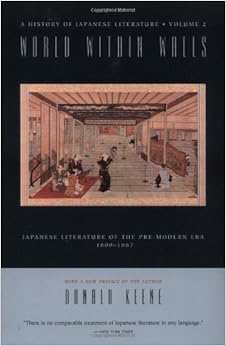
Free Downloads World Within Walls

The Tokugawa family held the shogunate from 1603 to 1867, ruling Japan and keeping the island nation isolated from the rest of the world for more than 250 years. Donald Keene looks within the "walls" of isolation and meticulously chronicles the period's vast literary output, providing both lay readers and scholars with the definitive history of premodern Japanese literature.World Within Walls spans the age in which Japanese literature began to reach a popular audience―as opposed to the elite aristocratic readers to whom it had previously been confined. Keene comprehensively treats each of the new, popular genres that arose, including haiku, Kabuki, and the witty, urbane prose of the newly ascendant merchant class.

Series: History of Japanese Literature (Book 2)
Paperback: 606 pages
Publisher: Columbia University Press; Revised edition (October 15, 1999)
Language: English
ISBN-10: 0231114672
ISBN-13: 978-0231114677
Product Dimensions: 6.1 x 1.1 x 9.2 inches
Shipping Weight: 1.9 pounds (View shipping rates and policies)
Average Customer Review: 5.0 out of 5 stars See all reviews (1 customer review)
Best Sellers Rank: #542,063 in Books (See Top 100 in Books) #54 in Books > Literature & Fiction > History & Criticism > Regional & Cultural > Asian > Japanese #173 in Books > Literature & Fiction > World Literature > Asian > Japanese #4244 in Books > Literature & Fiction > History & Criticism > Criticism & Theory

At first, I didn't expect finish reading this book, because it seemed like a hard academic one for me. But actually I could. Since this book is basically consisted of compact biographies of Japanese poets and writers, it's not difficult to follow the story and easy to understand. Through English translation like the filter of a camera, Japanese poetry, Haiku and Waka, looked different to me. They're fresh and interesting. By the comparison of Romanized Japanese poems and their English translations, I enjoyed the new aspects of Haiku and Waka and could find some true meanings of them as well.Teitoku Matunaga (poet), Ryoi Asai(writer), Nanboku Turuya(dramatist), and Kageki Kagawa(poet) are particularly interesting to me. I'd like to continue my reading to understand them more.
Framing Floors, Walls and Ceilings: Floors, Walls, and Ceilings (For Pros By Pros) Exploring Stone Walls: A Field Guide to New England's Stone Walls World Within Walls The War within These Walls Quick and Easy Paint Transformations: 50 step-by-step projects for walls, floors, stairs & furniture Annie Sloan Paints Everything: Step-by-step projects for your entire home, from walls, floors, and furniture, to curtains, blinds, pillows, and shades Behind Adobe Walls: The Hidden Homes and Gardens of Santa Fe and Taos Walls Notebook Data Abstraction and Problem Solving with C++: Walls and Mirrors (4th Edition) Intermediate Problem Solving and Data Structures: Walls and Mirrors (The Benjamin/Cummings Series in Computer Science) Data Abstraction and Problem Solving with C++: Walls and Mirrors (3rd Edition) Data Abstraction and Problem Solving with Java: Walls and Mirrors (3rd Edition) Building Stone Walls Ultimate Guide: Walks, Patios & Walls (Landscaping) Building Stone Walls: Storey's Country Wisdom Bulletin A-217 (Storey Country Wisdom Bulletin) The Granite Kiss: Traditions and Techniques of Building New England Stone Walls Gardening Vertically: 24 Ideas for Creating Your Own Green Walls White Walls: A Memoir About Motherhood, Daughterhood, and the Mess In Between Stone by Stone: The Magnificent History in New England's Stone Walls The Walls Around Us



